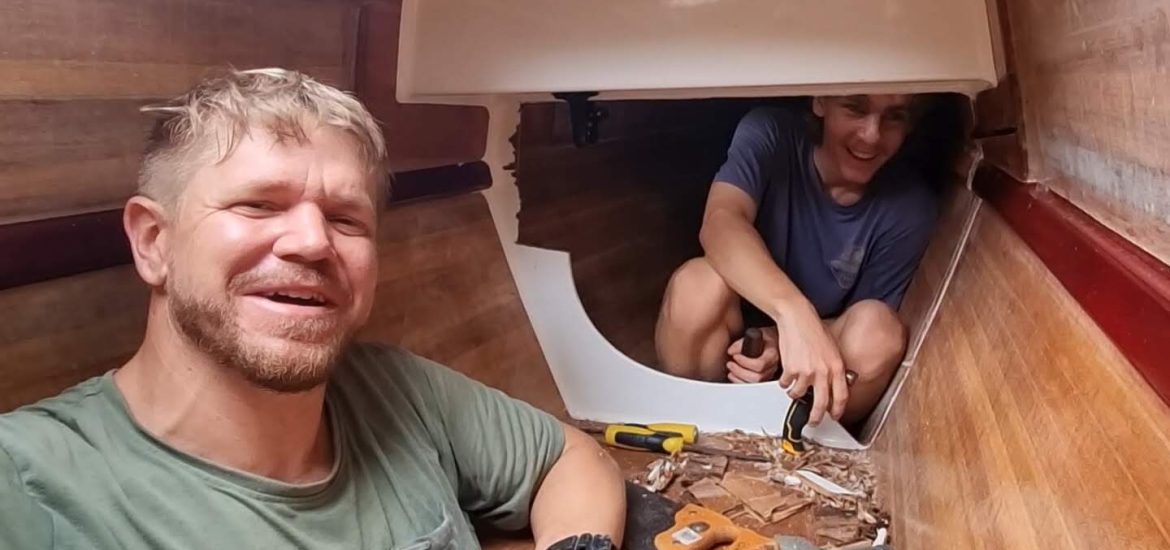The unveiling of the Vaka Hop’e went better than feared. Other than it being a little dirty and having small ecosystems growing in some places, it looked great! I was optimistic that we would have few problems in preparation for launching. Before leaving the boat I had written a little list of things to fix and repair, but that list was only in the back of my mind and half-forgotten. What was in front of me looked great!
However, one thing worried me. Had I been able to exterminate the termites before we left the year before? Port hull had been having continuous signs of termites during the previous sail, and before leaving I had gotten some insecticide and tried to kill them all. Upon inspection, it looked like I had killed most of them, but there were still some around. Sometimes it’s hard to see where they come from, but I found a new place and injected some insecticide. All in all, I was pleased with how well it looked. But there was one major area that was on my half-forgotten list, and the next day I was about to discover it.
On the forward bulkhead, we have some key blocks that align the beams and the decks. These have been the entry point of termites on our boat, and before I left I did a temporary fix on the stern area. On the bow, I had done less excavation and only a quick fix. As I inspected the area with a screwdriver, poking around, suddenly the screwdriver went straight through the plywood! Oh no… This is bad. I started poking around some more and discovered that the whole area was rotten by termite damage. As I went into the bow of the boat I could see that the rotten area extended quite far. I quickly realized that this was not going to be a quick fix.
But before I was going to start fixing the bulkhead, I needed to get Sammy and Paul started on the engine maintenance. Our 9.9 hp Yamaha outboard engine was brand new the previous season, but I hadn’t done the full service on it before leaving as I was too consumed by killing termites. So now we were just going to start it up, get it warm, and change the oil. However, the engine refused to start. We tried so many times and nothing worked. I checked the fuel, the spark, and the carburetor, and even though I have no experience with carburetors, it looked nice and clean. In the end, I decided to take the battery out and charge it. When taking it out I had forgotten to tilt the motor down, so I had to connect it back. When doing so I noticed that I put the wires on backwards. Or did I? Were the wires connected in reverse polarity from the beginning? Or had I only gotten them mixed up as I took the battery out? I never got an answer to that question, but as the saga continues we will be getting a better idea.
Our to-do list was never-ending and ever-growing. Keeping everyone occupied on different jobs took a lot out of me, but for now, our main focus was to fix the bulkhead. The engine would have to wait. Paul and I started the excavations, and in the end, we removed half the bulkhead. The termites loved our plywood, but they hadn’t gone into the main hull, thankfully! Now we would just have to find a way to rebuild it. We would need to get to town to get supplies; some marine plywood, fiberglass, and epoxy would be needed. It’s already the end of week one and we all desperately need a break. We go back to Davao by tuk-tuk, in the back of a truck, by ferry, and finally a taxi. We get to stay at the local YWAM base, and we are so thankful for the break.
We get a break and supplies and return to the Vaka Hop’e the next week with renewed energy. It’s been raining a lot lately, and this week would be no exception. But work goes on. Paul and Sammy work on making a template, and I join in in between. Naomi and I try to tick off as much as we can on our to-do list, but every time we do, more seem to be added on. The bulkhead template starts to take shape and soon we have had enough fiddling and decided to go for it. We traced out the template and started sawing the plywood. Due to the size of the bulkhead, we would have to saw it in half to fit it. In the end, I glued it in with the local marine epoxy, then fiberglassed it to the hull. It worked beautifully!
While sitting squeezed up in the bow of the boat, waiting for the epoxy putty to dry, I had some time to research the broken engine. And one night I had the inspiration I needed to keep trying. After half an hour of trying to get it started, it finally came to life! The engine was working! Now things were looking up and I was getting optimistic that we could start to assemble the boat the following week. However, the next day the engine was as stubborn as ever and would only start after half an hour of warming it up using the starter motor. At this point, we are at the end of the week and the end of our ropes. Even though we are staying at a beautiful place, we decide to go back to the YWAM base to get a break from the boat. Our first two weeks have been productive, but the outboard motor is troubling me. What is wrong? I would have to find out next week…
